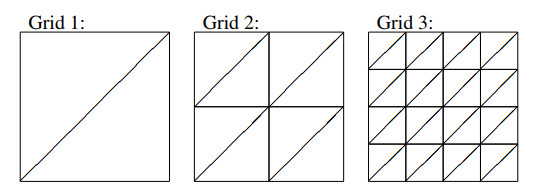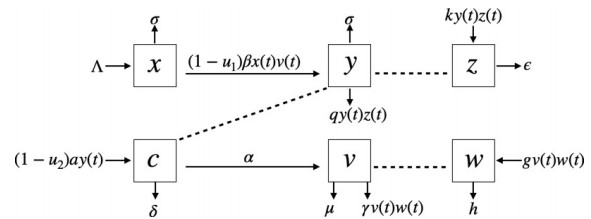1.
Introduction
In this manuscript, we detail the development of a new stabilizer-free weak Galerkin (WG) finite element method of any polynomial order in 2D and 3D, on triangular and tetrahedral meshes respectively, for obtaining the solutions of the stationary Stokes equations: Find unknown functions u (velocity) and p (pressure) such that
where the viscosity μ>0, and the domain Ω is a polygon or a polyhedron in Rd(d=2,3).
The new pressure-robust, stabilizer-free WG method has a new variational formulation. Find uh∈Vh and ph∈Wh such that
where ∇w denotes weak gradients to be defined in (2.3) and (2.4), and Vh and Wh are Pk and Pk−1 WG finite element spaces, to be defined in (2.1) and (2.2), respectively. Some studies on the WG methods are as follows: the parabolic equation [1,2,3], with two-order superconvergence on triangular meshes [4], the convection-diffusion equation [5,6], 4th order problems [7,8], with the conforming discontinuous Galerkin formulation [9,10,11], the Navier-Stokes equations [12,13,14], with the discrete maximum principle [15], the second order elliptic equations [16,17], with the energy conservation [18], the Darcy flow [19,20], the Oseen equations [21], the Stokes equations with pressure-robustness [22,23,24], the Maxwell equations [25], the Cahn-Hilliard equation [26], the div-curl equations [27], with adaptive refinements [28,29], the biharmonic equation [30,31], the biharmonic equation with continuous finite elements[32,33], the Stokes equations with H(div) elements [34,35], with two-order superconvergence under the CDG formulation [36,37], and with two-order superconvergence for the Stokes equations [38].
We note that the moment equation (1.1) is not tested by applying H(div,Ω) functions in (1.4), different from most other pressure-robust methods such as those detailed in [22,23,24], but is tested by using discontinuous polynomials. The pointwise divergence-free property (pressure-robustness) is achieved by introducing pressure face variables, i.e., ph={p0,pb} where pb|e∈Pk(e) on every face edge/triangle e of a mesh Th (see (2.2) below). The method was previously applied before in hybridized discontinuous Galerkin methods in [39].
It is shown that the WG finite element pair, Vh−Wh, is inf-sup stable. The method is shown pressure robust, i.e., both errors of the velocity and the pressure are independent of the pressure p and the viscosity μ in (1.1). This is necessary when μ is small. However, very few methods can achieve this. Under the inf-sup stability, we shall prove quasi-optimal approximation for the velocity in an H1-norm and in the L2 norm. The quasi-optimal convergence for pressure in the L2 norm is also proved. The theory is numerically verified by applying varying degrees of WG finite elements to both triangular and tetrahedral meshes.
2.
The WG finite element method
Let Th be a mesh on the domain Ω, consisting of conforming shape-regular triangles or shape-regular tetrahedrons. Here we let hT be the element diameter of T∈Th, and we let mesh size h=maxT∈ThhT.
For k≥1 and given Th, the finite element space for velocity is defined by
and the finite element space for pressure is defined by
where Pk(e) and Pk(T) denote the space of polynomials of degree k or less on the edge/triangle e and triangle/tetrahedron T respectively, (⋅,⋅)Th=∑T∈Th(⋅,⋅)T and ⟨⋅,⋅⟩∂Th=∑T∈Th⟨⋅,⋅⟩∂T.
For a function v∈Vh, the (k+1)-degree weak gradient ∇wv is a piecewise polynomial on the mesh Th, ∇wv|T∈[Pk+1(T)]d×d, such that
For a function q={q0,qb}∈Wh, its weak gradient ∇wq is defined as a piecewise vector-valued polynomial such that for each T∈Th, ∇wq∈[Pk(T)]d satisfies
We denote by Πk the local/element-wise L2-orthogonal projection onto [Pk(T)]j where j=1,d,d×d and T∈Th. Let Πbk be a generic edge/face-wise defined L2 projection onto [Pk(e)]j for e∈∂T. Define Qhu={Πku,Πbk+1u}∈Vh and Qhp={Πk−1p,Πbkp}∈Wh.
Lemma 2.1. Let ϕ∈[H10(Ω)]d and ψ∈H1(Ω), then, for T∈Th
Proof. Using (2.3) and integration by parts, we obtain the following for any τ∈[Pk+1(T)]d×d:
This implies that (2.5) holds. The scalar version, (2.6), is proved in the same manner.
For any function φ∈H1(T), the following trace inequality holds true:
We define two semi-norms |||v||| and ‖v‖1,h for any v∈Vh:
We also define two semi-norms |||q||| and ‖q‖1,h for any q∈Wh:
In fact, ‖v‖1,h is a norm in Vh and |||⋅||| is also a norm in Vh, as they have been proved in [4] by applying the norm equivalence as follows:
and
Lemma 2.2. The following inf-sup conditions hold, for all q={q0,qb}∈Wh and v={v0,vb}∈Vh:
and
where β>0 is independent of h and Th.
Proof. For any given q={q0,qb}∈Wh, it is known that there exists a function ˜v∈H0(div,Ω) and ˜v|T∈[Pk(T)]d (see, e.g., [40, (7.4)–(7.6)]) such that
where
Let
where T1 and T2 are the two elements on the two sides of edge/triangle e. For such specially defined v, we have
It follows from (2.13) and (2.17) that
By (2.4), we have
Combining (2.16), (2.19) and (2.18) implies that
which implies (2.14).
Next we shall derive (2.15). For any v={v0,0}∈Vh and τ∈[Pk+1(T)]d×d, we have the following by (2.3), (2.7) and the inverse inequalities:
which implies that
It follows from (2.20) that for any v={v0,0}∈Vh
Then we have
which implies (2.15). This completes the proof of the lemma.
Lemma 2.3. There is a unique solution for the WG finite element equations (1.4) and (1.5).
Proof. We only need to show that zero is the unique solution of (1.4) and (1.5) if f=0. We let f=0 and v=uh in (1.4) and q=ph in (1.5). By summing the two equations, we get
It implies that ∇wuh=0 on T. By (2.12), we also obtain that ‖uh‖1,h=0. Thus, uh=0.
Since uh=0 and f=0, (1.4) is reduced to (v0,∇wph)=0 for any v={v0,vb}∈Vh. Then the inf-sup conditions (2.15) and (2.14) imply that ∇wph=0 and p0=0. By (2.13), we have that ‖ph‖1,h=0 and p0=pb=0 on ∂T. We have proved the lemma.
3.
Error equations
To derive the equations that the errors satisfy, we introduce eh=Qhu−uh and ϵh=Qhp−ph.
Lemma 3.1. [41, Theorem 3.1] For τ∈[Hk+2(Ω)]d, a quasi-projection Πh can be defined such that Πhτ∈[H(div,Ω)]d, Πhτ|T∈[Pk+1(T)]d×d and for v0∈[Pk(T)]d,
where |⋅|k+2 is the semi-Hk+2 Sobolev norm on the space.
Lemma 3.2. [41, Theorem 3.1] Let τ∈Hk+1(Ω). A quasi-projection πh can be defined such that πhτ∈H(div,Ω), πhτ|T∈[Pk(T)]d and for q0∈Pk−1(T),
where |⋅|k+1 is the semi-Hk+1 Sobolev norm on the space.
Lemma 3.3. For any v∈Vh and q∈Wh, the following error equations hold true:
where
Proof. First, we test (1.1) by applying v0 with v={v0,vb}∈Vh to obtain
It follows from (3.2) and (2.5) that
It follows from (2.6) that
We substitute (3.12) and (3.13) into (3.11) to obtain
We subtract (3.14) from (1.4) to get
Multiplying (1.2) by q={q0,qb}∈Wh, by applying (3.2), it follows that
which implies that
The difference between (3.17) and (1.5) implies (3.8). We have proved the lemma.
4.
Quasi-optimal finite element solutions
We shall first prove the optimal order error estimates of the |||⋅||| norm for the velocity uh, and of the L2 norm for the pressure ph.
Lemma 4.1. Let u∈[Hk+1(Ω)]d, v∈Vh and q∈Wh. The following estimates hold:
where e1(⋅,⋅) and e2(⋅,⋅) have been defined in (3.9) and (3.10), respectively.
Proof. By the Cauchy-Schwarz inequality, the definitions of Πk+1 and Πh, we compute
Similarly, we have
We have proved the lemma.
Theorem 4.1. Let (u,p)∈([Hk+1(Ω)]d∩[H10(Ω)]d)×(Hk(Ω)∩L20(Ω)) be the solutions of (1.1)–(1.3). Let (uh,ph)∈Vh×Wh be the solutions of (1.4) and (1.5). Then, the following error estimates hold true:
Proof. It follows from (3.7) that for any v={v0,vb}∈Vh, by (4.1), we have
Then applying the estimate (4.5) and (2.15) yields
By letting v=eh in (3.7) and q=ϵh in (3.8), and by using (3.8), we have
It then follows from (4.1), (4.2) and (4.6) that
which implies (4.3). The estimate (4.4) follows from (4.5), (4.3) and the inf-sup conditions (2.14) and (2.15). We have proved the theorem.
We shall derive next the optimal-order convergence for velocity in the L2 norm by using the duality argument. Recall that eh={e0,eb}=Qhu−uh and ϵh=Qhp−ph. Consider the problem of seeking (ψ,ξ) such that
Assume that the duality problem given by (4.7)–(4.9) has the H2(Ω)×H1(Ω)-regularity property that the solution (ψ,ξ)∈H2(Ω)×H1(Ω) and the following a priori estimate holds true:
We need the following lemma first.
Lemma 4.2. For any v∈Vh and q∈Wh, the following equations hold true:
where ψ and ξ are defined in (4.7), and
Proof. Testing (4.7) by applying v0 with v={v0,vb}∈Vh gives
By performing integration by parts, and setting ⟨∇ψ⋅n,vb⟩∂Th=0, we derive
By integration by parts, and given(2.3) and (2.5), we have
Combining (4.14) and (4.15) gives
By applying the definition of Πk, (2.6), and (3.13), we obtain
Combining (4.16) and (4.17) with (4.13) yields (4.11).
Testing (4.8) by applying q0 with q={q0,qb}∈Wh gives
By applying integration by parts, we obtain
Combining (4.18) and (4.19) yields
We have proved the lemma.
By the same argument as that for (4.16), (3.7) has another form, i.e.,
Letting v=Qhψ and q=Qhξ in (4.21) and (4.22), we obtain
Letting v=eh and q=ϵh in (4.11) and (4.12), we have
By applying (4.26), (4.23) becomes
Theorem 4.2. Let (u,p)∈([Hk+1(Ω)]d∩[H10(Ω)]d)×(Hk(Ω)∩L20(Ω)) be the solutions of (1.1)–(1.3). Let (uh,ph)∈Vh×Wh denote the unique solutions of (1.4) and (1.5). With the condition (4.10), the following error bound holds:
Proof. Letting v=eh in (4.11) yields
By applying (4.27) and (4.24), (4.29) becomes
Next we shall estimate all of the terms on the right hand side of (4.30). Using the Cauchy-Schwarz inequality, the trace inequality (2.7), and the definition of Πk+1, we obtain
Similarly, we have
Using the Cauchy-Schwarz inequality and the trace inequalities, applying (2.12) and (4.3), we obtain
By (4.4), we have
Substituting all the four bounds above into (4.30), we get
By applying this inequality and the regularity condition (4.10), (4.28) is proved.
5.
Numerical test
In the first example in 2D, we have chosen the domain Ω=(0,1)×(0,1) for the Stokes equations (1.1)–(1.3). We have chosen an f (depending on μ) in (1.1) such that the exact solution of (1.1)–(1.3) is as follows (independent of μ):
We computed the solution (5.1) on triangular grids shown, as in Figure 1 for the Pk-WG/Pk−1-WG mixed finite elements for k=1,2,3,4, and 5. The results are listed in Tables 1–5. As shown, the optimal order of convergence has been achieved for all solutions in all norms. From the data, we can see the method is pressure-robust and the error is independent of the viscosity μ.
We note that for some high level grids the computer round-off error was found to exceed the truncation error when μ=10−6, as described in Tables 3–5.
We computed the 2D solution (5.1) again for slightly perturbed triangular meshes, as illustrated in Figure 2 by employing the Pk-WG/Pk−1-WG mixed finite elements for k=1,2,3,4 and 5. The computational results are listed in Tables 6–10. The quasi-optimal convergence has been achieved for all solutions in all norms.
In the third test, we performed 3D numerical computation on domain Ω=(0,1)×(0,1)×(0,1). We chose an f in (1.1) such that we would have the following exact solution
The 3D meshes are illustrated in Figure 3. The computational results are listed in Tables 11–13.
Use of AI tools declaration
The authors declare they have not used Artificial Intelligence (AI) tools in the creation of this article.
Acknowledgments
Yan Yang is supported in part by the Program of Sichuan National Applied Mathematics Center, No. 2023-KFJJ-01-001.
Conflict of interest
The authors declare there are no conflicts of interest.










 DownLoad:
DownLoad:













